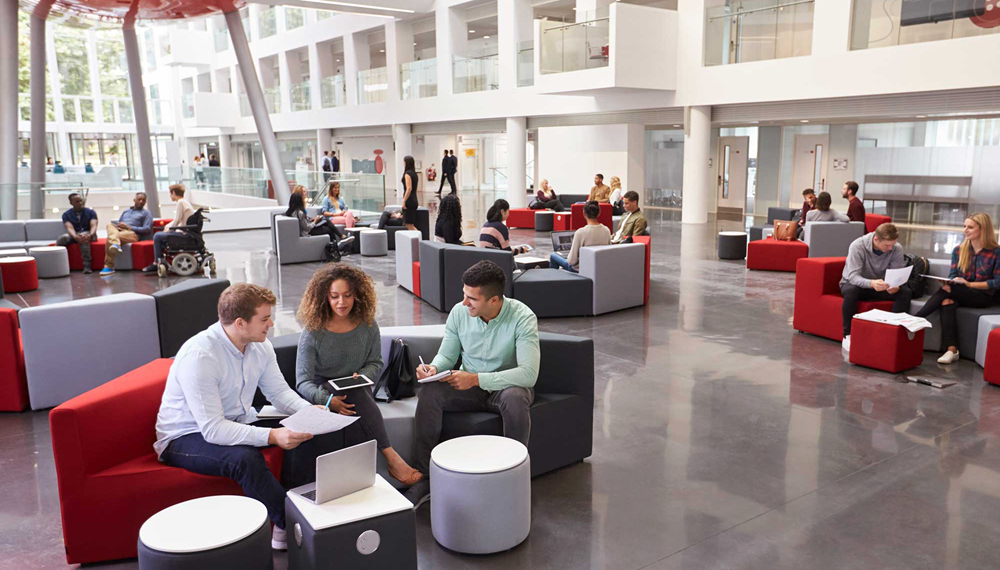
Cultivate tenant experiences for hybrid workers
The commercial real estate industry is facing a critical turning point, and the time to embrace change is right now. As the world continues to reopen, we know that forever more people will continue to work from anywhere.
In May, a local publication reported that, for the past year, Denver’s office market had more space vacated than absorbed, according to a market report from CBRE. At the end of the first quarter, the market-wide vacancy rate was 16.8%, the highest it had been since 2010, and downtown’s rate was 19.7%. A comment from Hilary Barnett, a CBRE vice president focused on downtown office space, indicated CBRE was seeing a significant uptick in the market. “Big blocks of space to space set up for smaller tenants is drawing interest as companies prepare to return to in-person work, at least in part,” she said.
This news is promising and not surprising as COVID-19 cases continue to decrease and vaccination rates increase. Businesses are start.ing to feel more comfortable about having their employees return to work at the office. However, the reality is that many businesses are going to need to remain flexible and offer remote working options that don’t require people to work in the physical office.
A recent Gallup poll suggests that 45% of full-time workers in the U.S. continue to work remotely for at least part of their work week. That number climbs to almost 70% among white-collar workers. Further, 30% of people working remotely would prefer to keep working that way as much as possible, even after health restrictions are lifted. Many other surveys show the majority of workers want to continue to have flexible work options. This desire and need for flexibility will result in businesses requiring less space, changing how they utilize their space and, most importantly, their need to focus on the experience they offer employees to support and encourage the return to the office.
What does all of this mean for the future of tenant experience? Well, it means that tenant experience is more important than ever – not just for business owners, but also for building operators.
Just as business owners recognize the workplace experience they offer their employees is critical to driving engagement, we are seeing a growing commitment from building operators to take on this challenge and consider what their role is in the effort to make the physical workplace safe and highly desirable.
The office is the physical heart of an organization, where colleagues come together to collaborate, connect and build community. Recognizing that people will continue to work from home, as well as spend time in the office, commercial real estate operators need to be thinking about the experience they want to offer their tenants in this new ecosystem of working from anywhere. Buildings should strive to be the hub and home base from which all other external workspaces extend out from to become the true center point of an organization’s connection to its employees.
If the office is seen as the home base, it is an office building’s responsibility to play a role in helping make the return to work as exciting as it is important. Tenants need to be reminded of the many reasons why coming back to the office is critical. Building community, creating connections with colleagues, networking and attending events are just a few of the many benefits of spending time at the office that have been sorely missed over the last year of working remotely and being socially distanced.
In particular, buildings should consider developing a communication strategy to help reach and engage tenants in real time, no matter where they are. In response to the safety and security concerns resulting from COVID-19, many buildings have introduced various systems and protocols to ensure the health and well-being of their occupants. Timely communication is essential to demonstrate and remind tenants as these measures occur. Technology will be an effective tool to significantly enhance any digital communications strategy. A poster in the lobby or a video screen in an elevator is not enough to reach everyone immediately, especially when some will be working outside of the building, at least some of the time. Buildings need to reach occupants well before they even enter the building. In fact, tech-enabled communication should be seen as a driver of influencing a tenant’s decision to return to the building workplace.
As the workplace repopulates, buildings need to find new and innovative ways to demonstrate value and elevate their tenants’ experience. The more they give to the community, the more likely tenants are going to engage and make the workplace a desirable place to be. This will benefit the businesses that occupy space, as well as the building itself, and help position the office as an important destination, one that is worth returning to.
The opportunity to create a proprietary tenant experience will become the new differentiator in commercial real estate. It’s not about the physical space, it’s about the experience that people encounter when visiting or working in the building. From in-person or virtual health and well-being protocols and programming to amenities, and from two-way communication to tenant appreciation events, the opportunity to engage and delight occupants is what will raise the ten-ant experience buildings offer to elite status.
It often has been said that commercial real estate needs to learn from the hospitality industry, and think about what it can do each and every day to earn the loyalty of its customers and make tenant experience job No. 1.
- June 23, 2021


